Design and Analysis of a Flexible Smart Apparel MIMO Antenna for Bio-Healthcare Applications
Abstract
1. Introduction
2. Antenna Design
2.1. Unit Cell Design
2.2. MIMO Antenna Design
3. Discussion of the Findings
3.1. Scattering Parameters
3.2. Radiation Characteristics
- is the power delivered by the transmitting antenna, and is the power available at the receiving antenna.
- is the transmitter antenna gain, and is the receiver antenna gain.
- is the wavelength, and is the distance between the transmitter and receiver.
4. Diversity Performance
5. Bending Analysis
6. SAR Analysis
- In comparison to the other antenna designs, the proposed four-port MIMO antenna size is relatively small.
- The proposed structure is a compact MIMO antenna composed of four resonators with dimensions of 0.52 × 0.52 × 0.015, where represents the lowest operating frequency.
- The proposed antenna is made of cost-effective textile material, and it is constructed with simple-to-fabricate structures.
- The proposed antenna is lightweight and easy to integrate into the human body.
- The proposed antenna fabrication process is simple, easy, and inexpensive, and it allows for easy integration into clothing.
- The flexibility of the proposed antenna is evaluated using bending analysis at different bending radii.
- The proposed antenna has high durability, resistance to wrinkles, and resistance to strain due to the use of the substrate polyester.
- The rectangular human body model and the imported human body CAD model showed low SAR values.
- The proposed MIMO antenna has two polarization vectors (vertical and horizontal) and exhibits polarization diversity.
7. Conclusions
Author Contributions
Funding
Institutional Review Board Statement
Informed Consent Statement
Data Availability Statement
Acknowledgments
Conflicts of Interest
References
- Alemaryeen, A.; Noghanian, S. On-Body Low-Profile Textile Antenna With Artificial Magnetic Conductor. IEEE Trans. Antennas Propag. 2019, 67, 3649–3656. [Google Scholar] [CrossRef]
- Singh, R.K.; Michel, A.; Nepa, P.; Salvatore, A.; Terraroli, M.; Perego, P. Compact and Wearable Yagi-Like Textile Antennas for Near-Field UHF-RFID Readers. IEEE Trans. Antennas Propag. 2021, 69, 1324–1333. [Google Scholar] [CrossRef]
- Yamanaka, D.; Takahashi, M. Investigation of the Characteristics of a 5.2 GHz Textile Antenna on a Human Body. In Proceedings of the 2019 Wireless Days (WD), Manchester, UK, 24–26 April 2019; pp. 1–4. [Google Scholar] [CrossRef]
- El Gharbi, M.; Martinez-Estrada, M.; Fernandez-Garcia, R.; Gil, I. Determination of Salinity and Sugar Concentration by Means of a Circular-Ring Monopole Textile Antenna-Based Sensor. IEEE Sens. J. 2021, 21, 23751–23760. [Google Scholar] [CrossRef]
- Zaidi, N.I.; Rahman, N.H.A.; Yahya, M.F.; Nordin, M.S.A.; Subahir, S.; Yamada, Y.; Majumdar, A. Analysis on Bending Performance of the Electro-Textile Antennas With Bandwidth Enhancement for Wearable Tracking Application. IEEE Access 2022, 10, 31800–31820. [Google Scholar] [CrossRef]
- Celenk, E.; Tokan, N.T. All-Textile On-Body Antenna for Military Applications. IEEE Antennas Wirel. Propag. Lett. 2022, 21, 1065–1069. [Google Scholar] [CrossRef]
- Hashim, F.F.; Mahadi, W.N.L.B.; Latef, T.B.A.; Bin Othman, M. Key Factors in the Implementation of Wearable Antennas for WBNs and ISM Applications: A Review WBNs and ISM Applications: A Review. Electronics 2022, 11, 2470. [Google Scholar] [CrossRef]
- Bartone, C.G.; Moore, L.; Kohli, M. An e-textile antenna for body area network. In Proceedings of the 2016 IEEE International Symposium on Antennas and Propagation (APSURSI), Fajardo, PR, USA, 26 June 2016–1 July 2016; pp. 999–1000. [Google Scholar] [CrossRef]
- Velan, S.; Sundarsingh, E.F.; Kanagasabai, M.; Sarma, A.K.; Raviteja, C.; Sivasamy, R.; Pakkathillam, J.K. Dual-Band EBG Integrated Monopole Antenna Deploying Fractal Geometry for Wearable Applications. IEEE Antennas Wirel. Propag. Lett. 2015, 14, 249–252. [Google Scholar] [CrossRef]
- Sundarsingh, E.F.; Velan, S.; Kanagasabai, M.; Sarma, A.K.; Raviteja, C.; Alsath, M.G.N. Polygon-Shaped Slotted Dual-Band Antenna for Wearable Applications. IEEE Antennas Wirel. Propag. Lett. 2014, 13, 611–614. [Google Scholar] [CrossRef]
- Memon, A.W.; Depaula, I.L.; Malengier, B.; Vasile, S.; Van Torre, P.; Van Langenhove, L. Breathable Textile Rectangular Ring Microstrip Patch Antenna at 2.45 GHz for Wearable Applications. Sensors 2021, 21, 1635. [Google Scholar] [CrossRef]
- Khan, S.; Kumar Singh, V.; Naresh, B. Textile antenna using jeans substrate for wireless communication application. Int. J. Eng. Tech. Sci. Res. 2015, 2, 176–181. [Google Scholar]
- Zhong, J.; Kiourti, A.; Sebastian, T.; Bayram, Y.; Volakis, J.L. Conformal Load-Bearing Spiral Antenna on Conductive Textile Threads. IEEE Antennas Wirel. Propag. Lett. 2016, 16, 230–233. [Google Scholar] [CrossRef]
- Kiourti, A.; Lee, C.; Volakis, J.L. Fabrication of Textile Antennas and Circuits With 0.1 mm Precision. IEEE Antennas Wirel. Propag. Lett. 2016, 15, 151–153. [Google Scholar] [CrossRef]
- Pulanthran, K.; Jizat, N.; Islam, S. A Low-cost Textile Antenna using Thermal-transfer Printing. In Proceedings of the 2020 16th IEEE International Colloquium on Signal Processing & Its Applications (CSPA), Langkawi, Malaysia, 28–29 February 2020; pp. 162–165. [Google Scholar] [CrossRef]
- Bonefačić, D. Textile Antenna as Moisture Sensor. In Proceedings of the 14th European Conference on Antennas and Propaga-tion (EuCAP 2020), Copenhagen, Denmark, 15–20 March 2020; pp. 1–3. [Google Scholar] [CrossRef]
- Mollah, G.; Shikder, K.; Arifin, F. Design and Evaluation of a SWB Decagonal Patch Textile Antenna for WBAN Applications. In Proceedings of the IEEE Region 10 Symposium (TENSYMP), Dhaka, Bangladesh, 5–7 June 2020; pp. 1420–1423. [Google Scholar] [CrossRef]
- Kang, D.-G.; Tak, J.; Choi, J. MIMO Antenna with High Isolation for WBAN Applications. Int. J. Antennas Propag. 2015, 2015, 370763. [Google Scholar] [CrossRef]
- Yang, S.; Liang, L.; Wang, W.; Fang, Z.; Zheng, Y. Wideband Gain Enhancement of an AMC Cavity-Backed Dual-Polarized Antenna. IEEE Trans. Veh. Technol. 2021, 70, 12703–12712. [Google Scholar] [CrossRef]
- Ashyap, A.Y.I.; Abidin, Z.Z.; Dahlan, S.H.; Majid, H.A.; Shah, S.M.; Kamarudin, M.R.; Alomainy, A. Compact and Low-Profile Textile EBG-Based Antenna for Wearable Medical Applications. IEEE Antennas Wirel. Propag. Lett. 2017, 16, 2550–2553. [Google Scholar] [CrossRef]
- Wissem, E.M.; Sfar, I.; Osman, L.; Ribero, J.-M. A Textile EBG-Based Antenna for Future 5G-IoT Millimeter-Wave Applications. Electronics 2021, 10, 154. [Google Scholar] [CrossRef]
- Kannappan, L.; Palaniswamy, S.K.; Kanagasabai, M.; Kumar, P.; Alsath, M.G.N.; Kumar, S.; Rao, T.R.; Marey, M.; Aggarwal, A.; Pakkathillam, J.K. 3-D twelve-port multi-service diversity antenna for automotive communications. Sci. Rep. 2022, 12, 403. [Google Scholar] [CrossRef]
- Ray, K.P. Design Aspects of Printed Monopole Antennas for Ultra-Wide Band Applications. Int. J. Antennas Propag. 2008, 2008, 713858. [Google Scholar] [CrossRef]
- Sadiq, M.S.; Ruan, C.; Nawaz, H.; Abbasi, M.A.B.; Nikolaou, S. Mutual Coupling Reduction between Finite Spaced Planar Antenna Elements Using Modified Ground Structure. Electronics 2021, 10, 19. [Google Scholar] [CrossRef]
- Kiem, N.K.; Phuong, H.N.B.; Chien, D.N. Design of Compact 4 × 4 UWB-MIMO Antenna with WLAN Band Rejection. Int. J. Antennas Propag. 2014, 2014, 539094. [Google Scholar] [CrossRef]
- Huang, Y.K. Antennas: From Theory to Practice; John Wiley & Sons: Hoboken, NJ, USA, 2021. [Google Scholar]
- Potti, D.; Tusharika, Y.; Alsath, M.G.N.; Kirubaveni, S.; Kanagasabai, M.; Sankararajan, R.; Narendhiran, S.; Bhargav, P.B. A Novel Optically Transparent UWB Antenna for Automotive MIMO Communications. IEEE Trans. Antennas Propag. 2021, 69, 3821–3828. [Google Scholar] [CrossRef]
- Zhang, C.; Chen, Z.; Shi, X.; Yang, Q.; Dong, G.; Wei, X.; Liu, G. A Dual-Band Eight-Element MIMO Antenna Array for Future Ultrathin Mobile Terminals. Micromachines 2022, 13, 1267. [Google Scholar] [CrossRef] [PubMed]
- Wang, F.; Duan, Z.; Wang, X.; Zhou, Q.; Gong, Y. High Isolation Millimeter-Wave Wideband MIMO Antenna for 5G Communication. Int. J. Antennas Propag. 2019, 2019, 4283010. [Google Scholar] [CrossRef]
- Govindan, T.; Palaniswamy, S.K.; Kanagasabai, M.; Kumar, S.; Rao, T.R.; Alsath, M.G.N. Conformal Quad-Port UWB MIMO Antenna for Body-Worn Applications. Int. J. Antennas Propag. 2021, 2021, 9409785. [Google Scholar] [CrossRef]
- Choukiker, Y.K.; Sharma, S.K.; Behera, S.K. Hybrid Fractal Shape Planar Monopole Antenna Covering Multiband Wireless Communications With MIMO Implementation for Handheld Mobile Devices. IEEE Trans. Antennas Propag. 2014, 62, 1483–1488. [Google Scholar] [CrossRef]
- Mohandoss, S.; Palaniswamy, S.K.; Thipparaju, R.R.; Kanagasabai, M.; Naga, B.R.B.; Kumar, S. On the bending and time domain analysis of compact wideband flexible monopole antennas. AEU—Int. J. Electron. Commun. 2019, 101, 168–181. [Google Scholar] [CrossRef]
- Martinez, I.; Mao, C.-X.; Vital, D.; Shahariar, H.; Werner, D.H.; Jur, J.S.; Bhardwaj, S. Compact, Low-Profile and Robust Textile Antennas With Improved Bandwidth for Easy Garment Integration. IEEE Access 2020, 8, 77490–77500. [Google Scholar] [CrossRef]
- Gabriel, S.; Lau, R.W.; Gabriel, C. The dielectric properties of biological tissues: II. Measurements in the frequency range 10 Hz to 20 GHz. Phys. Med. Biol. 1996, 41, 2251–2269. [Google Scholar] [CrossRef]
- Available online: https://free3d.com/3d-models/human (accessed on 18 October 2022).
- Parameswari, S.; Chitra, C. Textile UWB Antenna with Metamaterial for Healthcare Monitoring. Int. J. Antennas Propag. 2021, 2021, 5855626. [Google Scholar] [CrossRef]
- Varma, S.; Sharma, S.; John, M.; Bharadwaj, R.; Dhawan, A.; Koul, S.K. Design and Performance Analysis of Compact Wearable Textile Antennas for IoT and Body-Centric Communication Applications. Int. J. Antennas Propag. 2021, 2021, 7698765. [Google Scholar] [CrossRef]
- Ashtankar, T.; Choudhari, N.K.; Pathan, T.U. Design and Analysis of a Compact MIMO Textile Antenna with Improved Mutual Coupling for WBAN Applications. IOSR J. Electr. Electron. Eng. (IOSR-JEEE) 2020, 15, 8–13. [Google Scholar]
- Singh, H.; Kanaujia, B.K.; Kumar, A.; Srivastava, K.; Kumar, S. Wideband textile multiple-input-multiple-output antenna for industrial, scientific and medical (ISM) /wearable applications. Int. J. RF Microw. Comput. Eng. 2020, 30, e22451. [Google Scholar] [CrossRef]
- Khajeh-Khalili, F. A broadband all-textile wearable MIMO antenna for wireless telecommunication/medical applications. J. Text. Inst. 2020, 112, 2013–2020. [Google Scholar] [CrossRef]
- Desai, A.; Palandoken, M.; Kulkarni, J.; Byun, G.; Nguyen, T.K. Wideband Flexible/Transparent Connected-Ground MIMO Antennas for Sub-6 GHz 5G and WLAN Applications. IEEE Access 2021, 9, 147003–147015. [Google Scholar] [CrossRef]
- Mashagba, H.A.; Rahim, A.H.; Adam, I.; Jamaluddin, M.H.; Yasin, M.N.M.; Jusoh, M.; Sabapathy, T.; Abdulmalek, M.; Al-Hadi, A.A.; Ismail, A.M.; et al. A Hybrid Mutual Coupling Reduction Technique in a Dual-Band MIMO Textile Antenna for WBAN and 5G Applications. IEEE Access 2021, 9, 150768–150780. [Google Scholar] [CrossRef]
- Punna, B.; Muthusamy, P. Compact Textile MIMO Antenna with Reconfigurable Dual Band Notching Characteristics for UWB Applications. In Proceedings of the 2021 IEEE Indian Conference on Antennas and Propagation, Jaipur, Rajasthan, India, 13–16 December 2021; pp. 859–862. [Google Scholar] [CrossRef]
- Jha, P.; Kumar, A.; De, A.; Jain, R.K. Flexible and Textile Two-port compact antenna for WLAN and wearable applications. In Proceedings of the 2021 8th International Conference on Signal Processing and Integrated Networks (SPIN), Noida, India, 26–27 August 2021; pp. 308–311. [Google Scholar] [CrossRef]
- Li, W.; Hei, Y.; Grubb, P.M.; Shi, X.; Chen, R.T. Compact Inkjet-Printed Flexible MIMO Antenna for UWB Applications. IEEE Access 2018, 6, 50290–50298. [Google Scholar] [CrossRef]
- Bayarzaya, B.; Hussain, N.; Awan, W.A.; Sufian, M.A.; Abbas, A.; Choi, D.; Lee, J.; Kim, N. A Compact MIMO Antenna with Improved Isolation for ISM, Sub-6 GHz, and WLAN Application. Micromachines 2022, 13, 1355. [Google Scholar] [CrossRef] [PubMed]
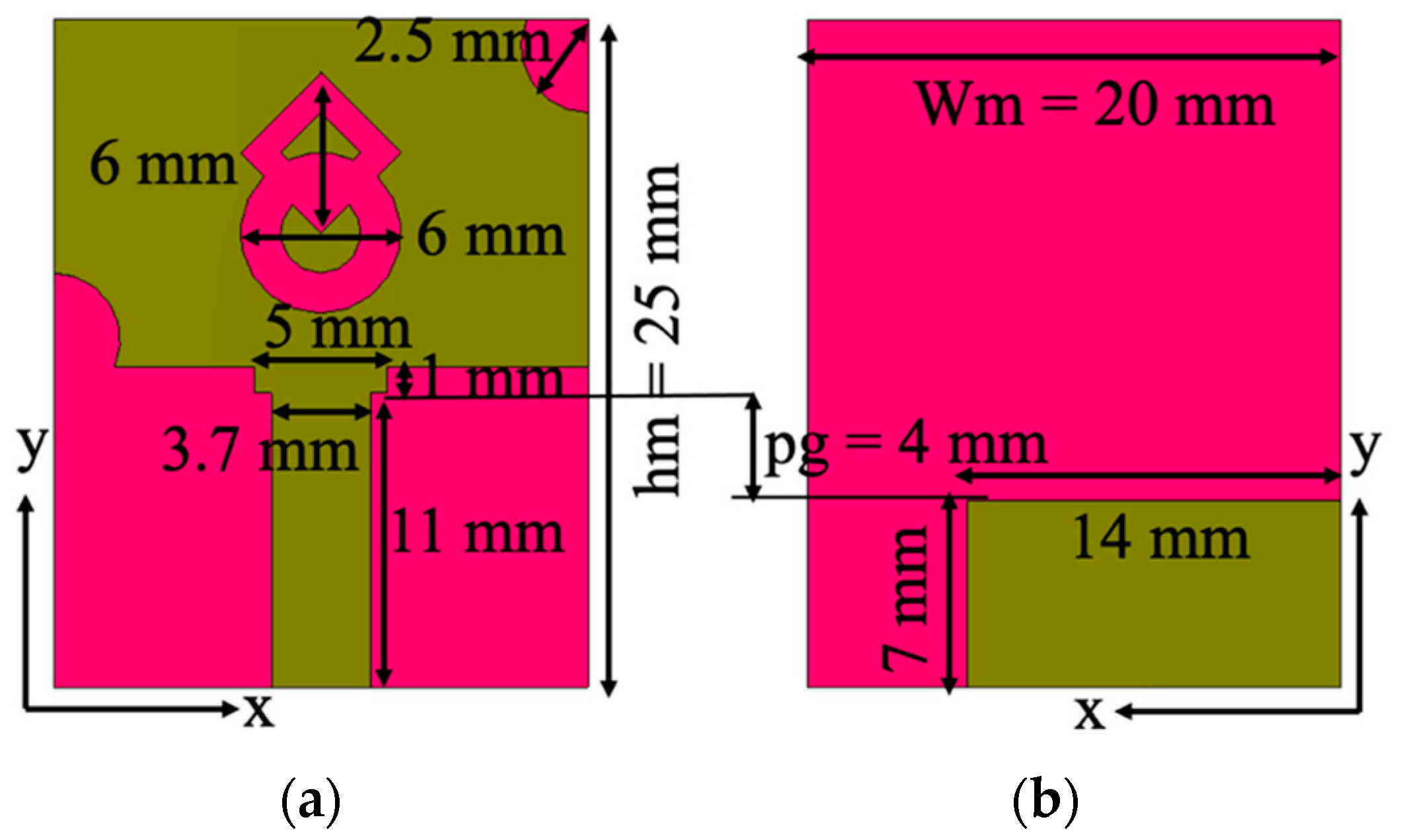
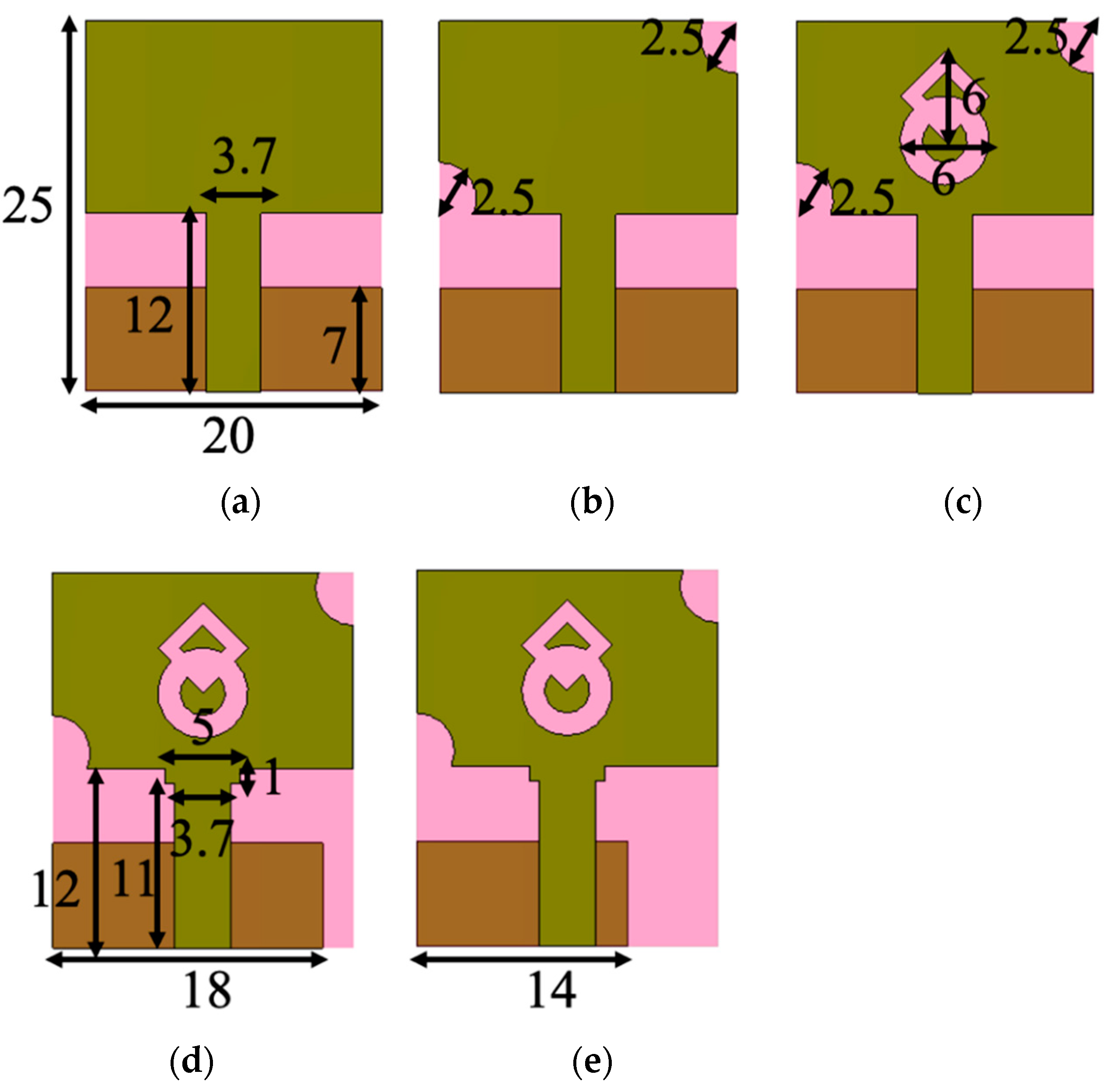


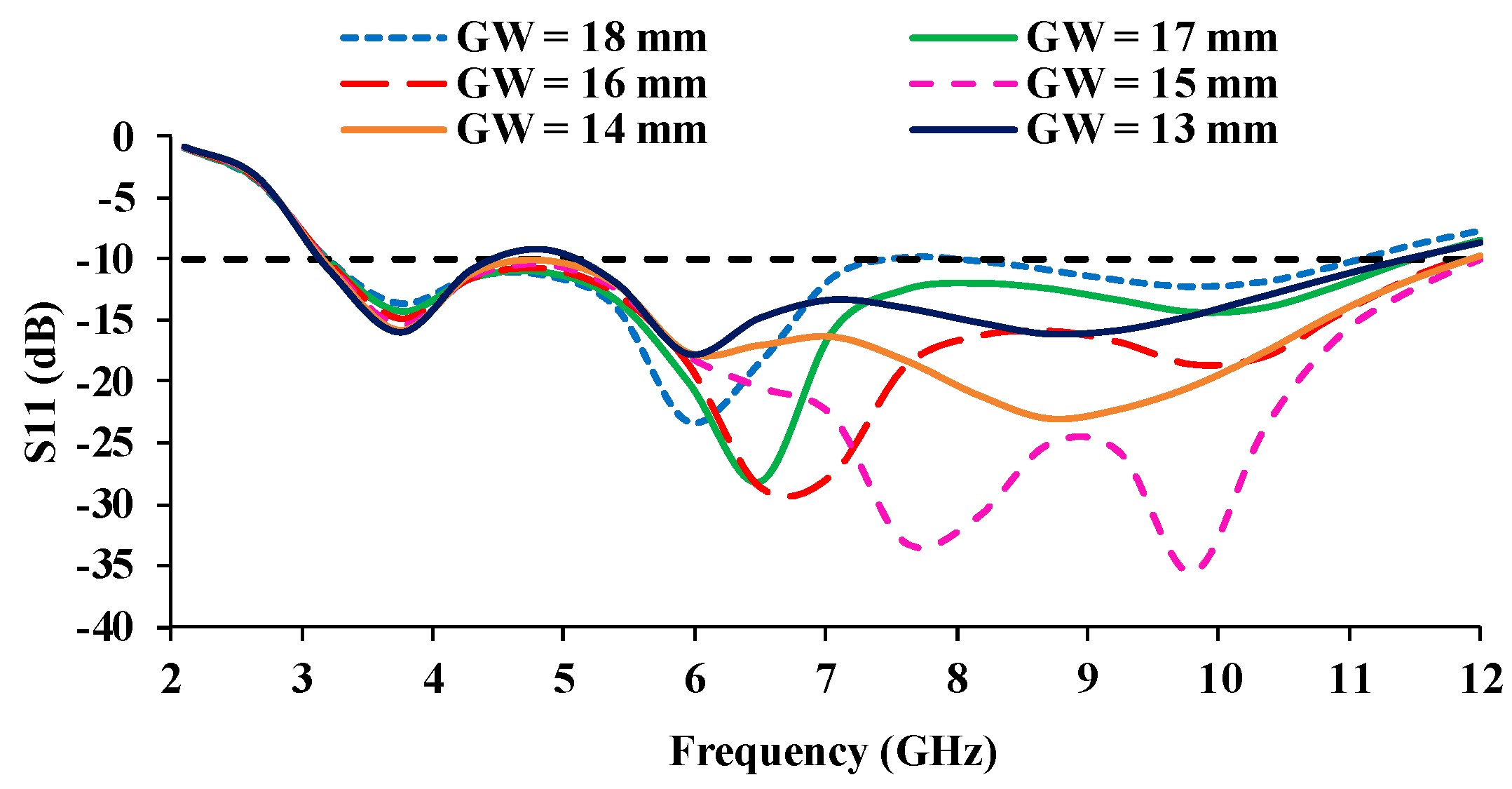
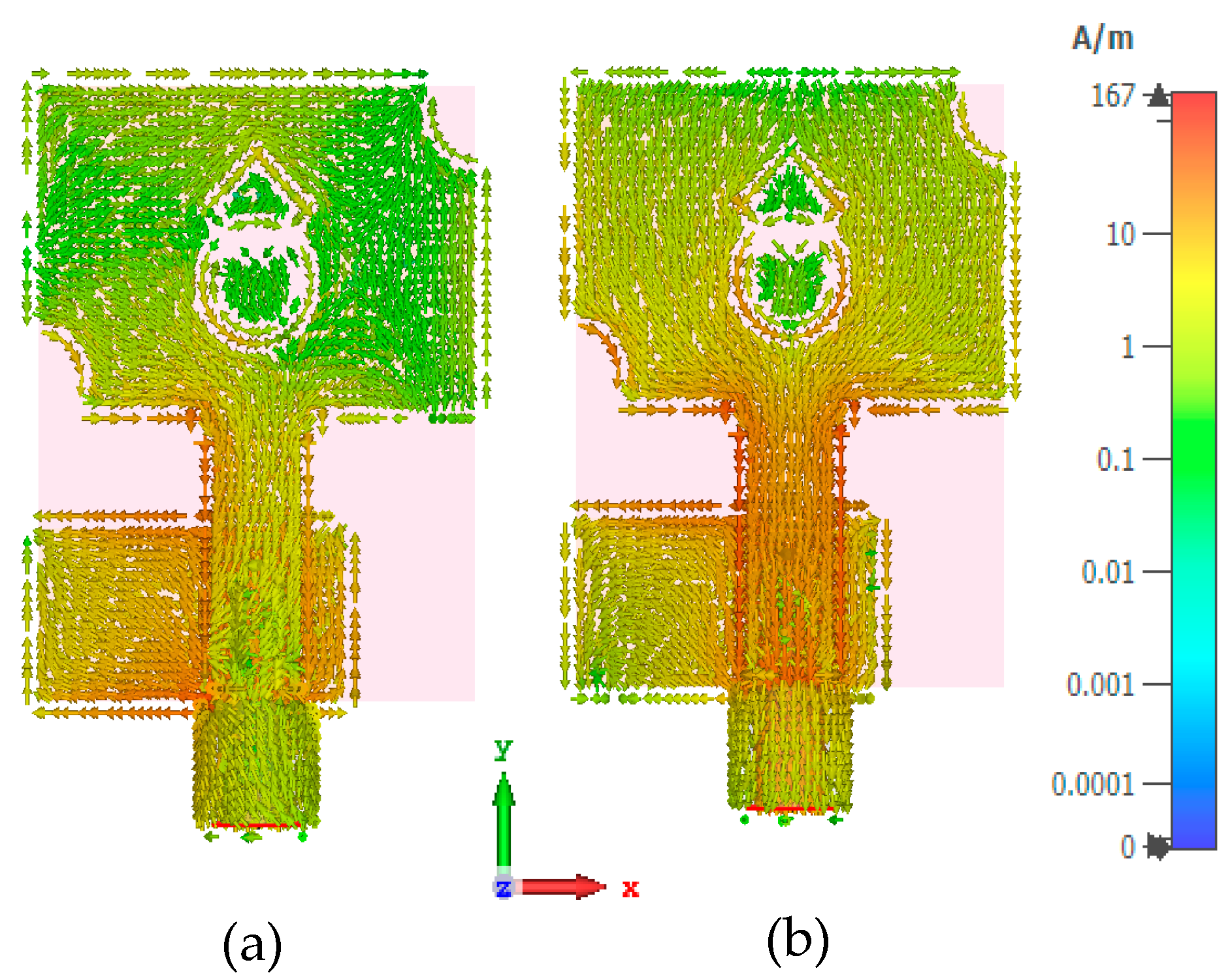

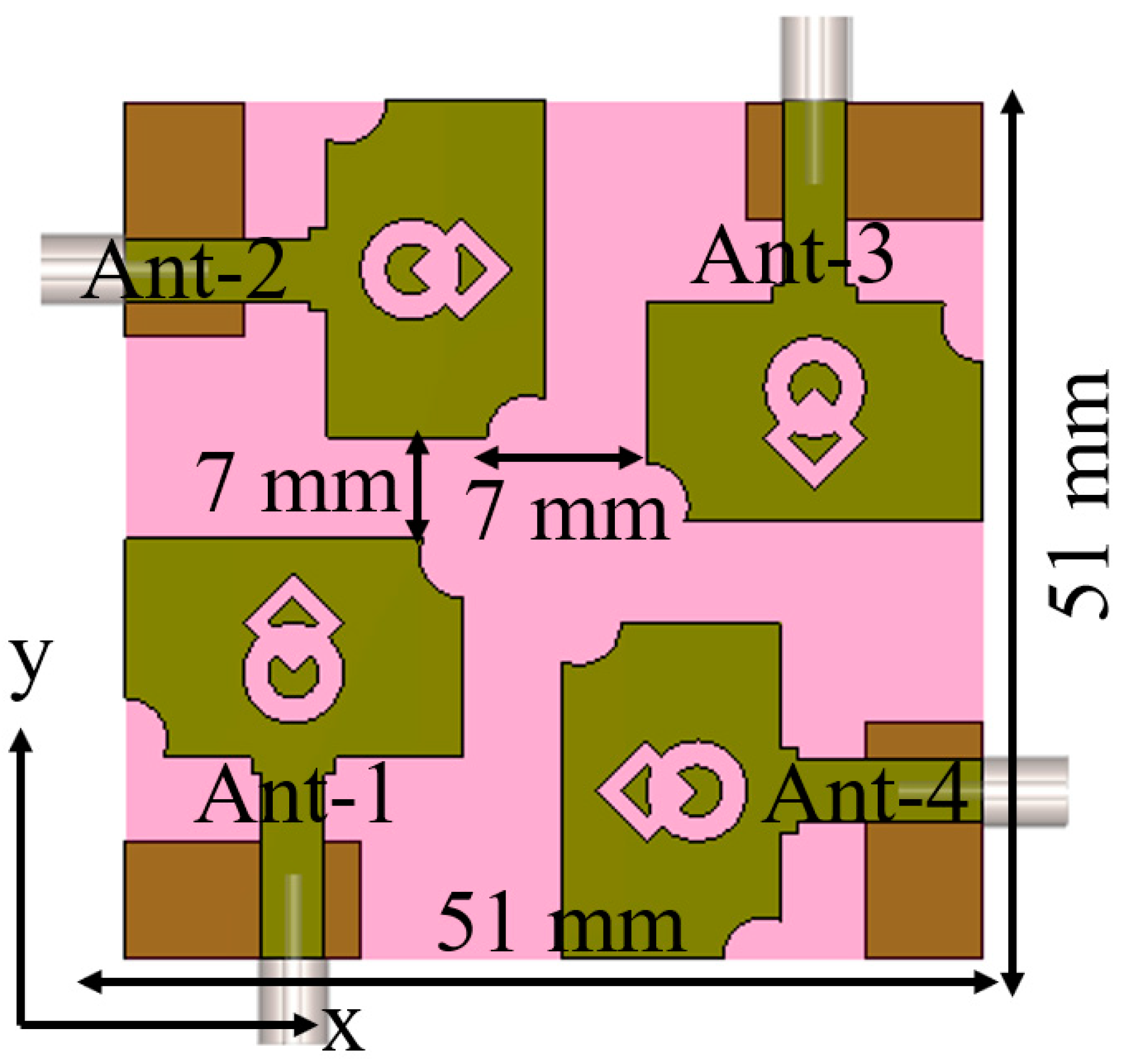
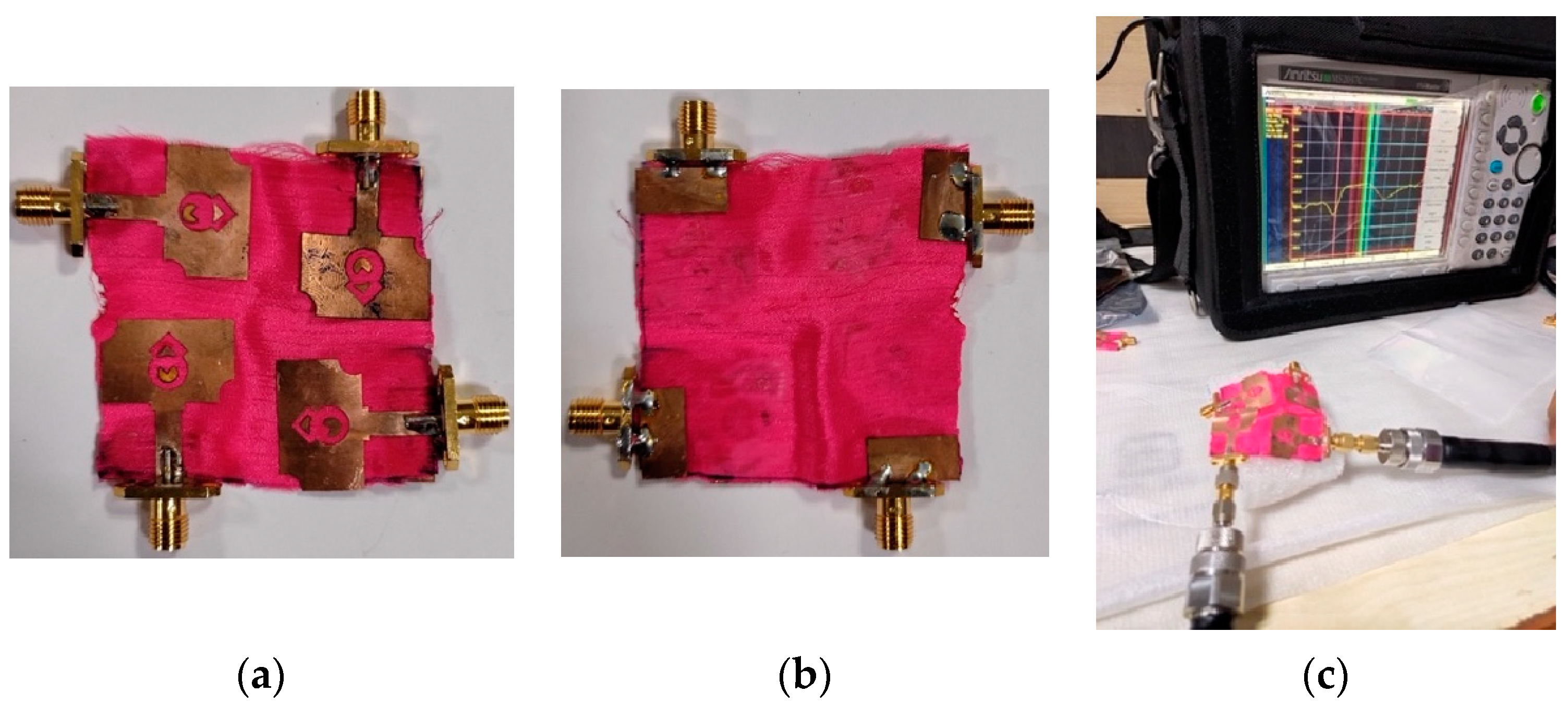
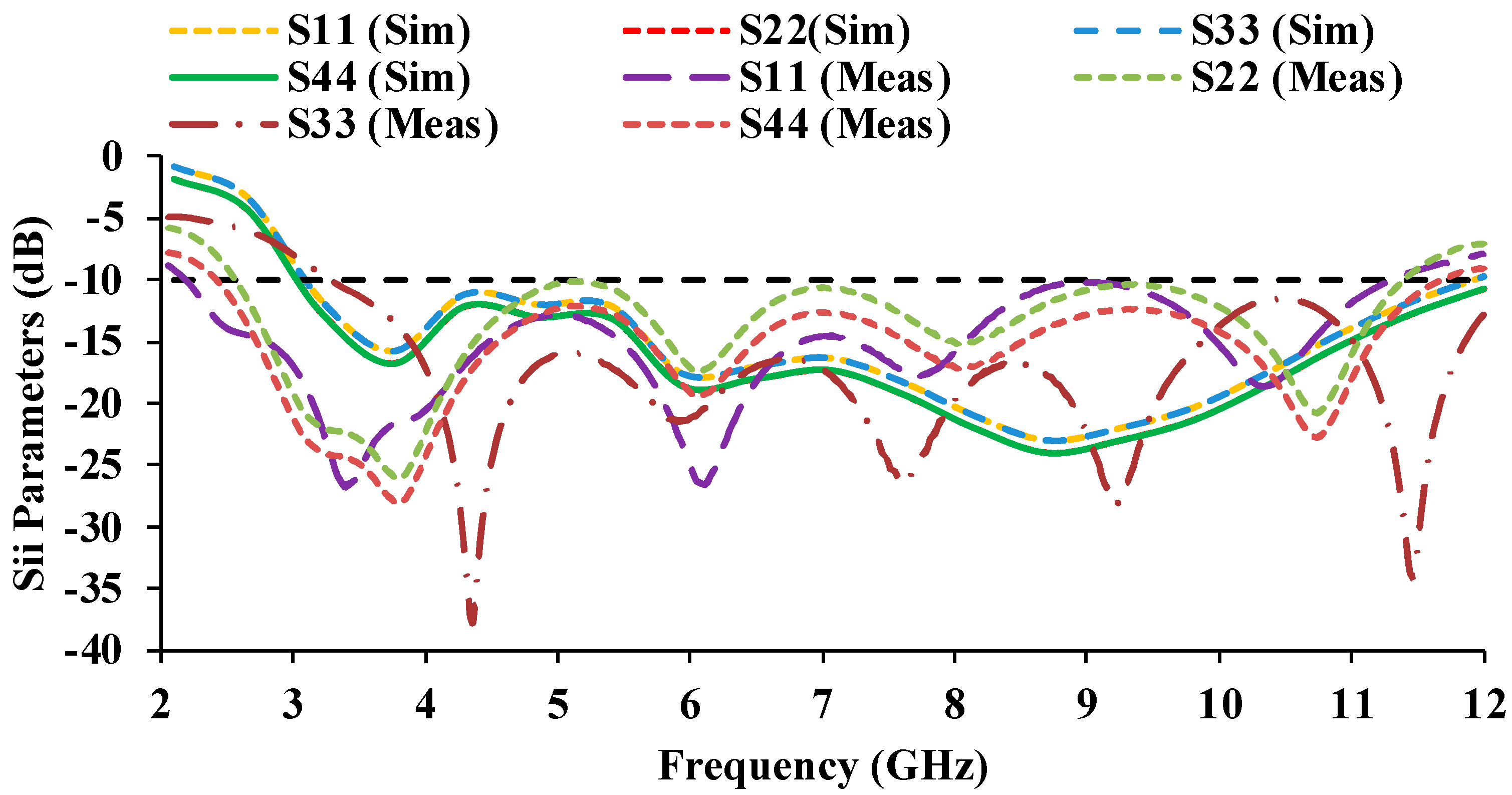
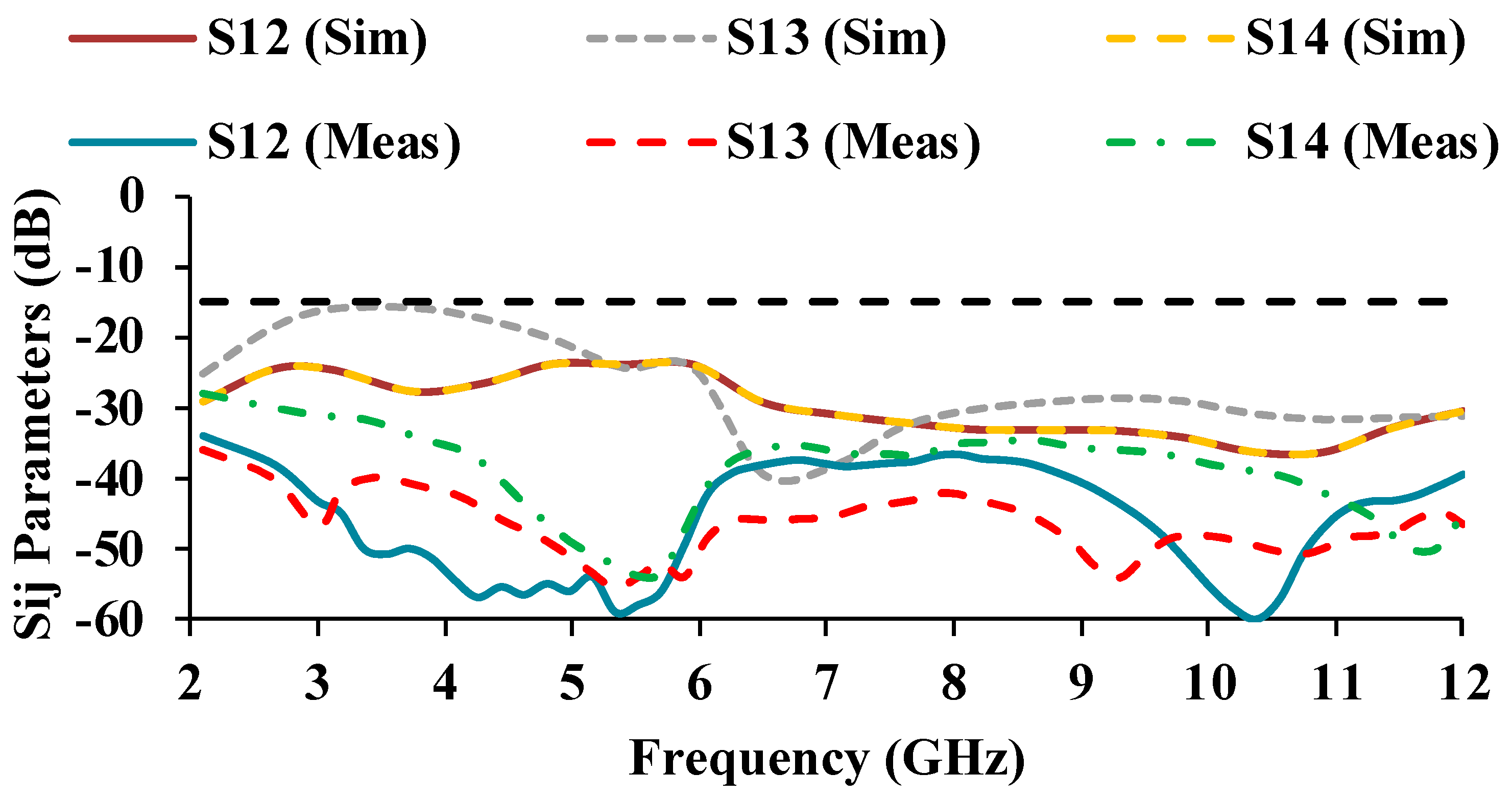
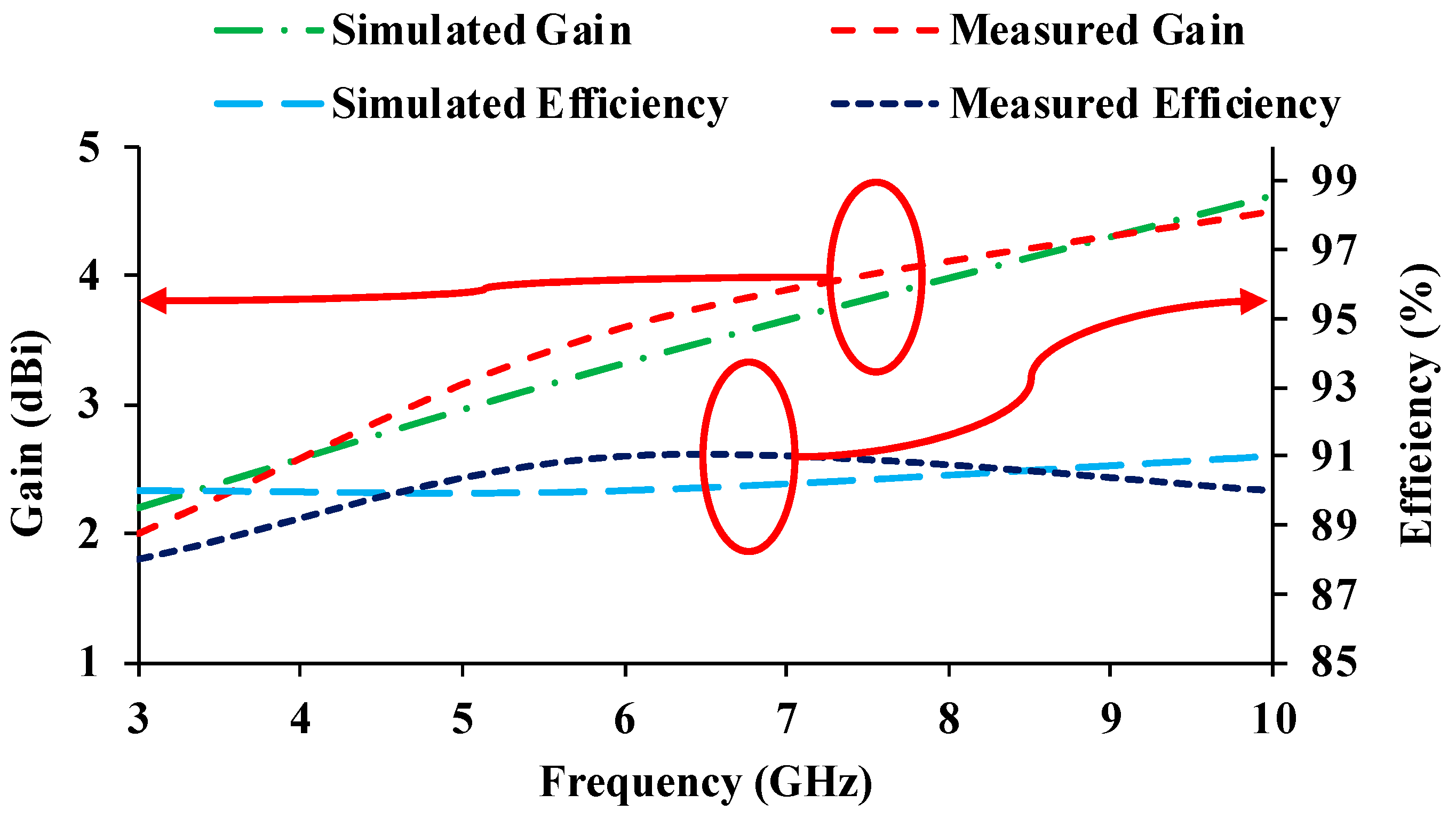
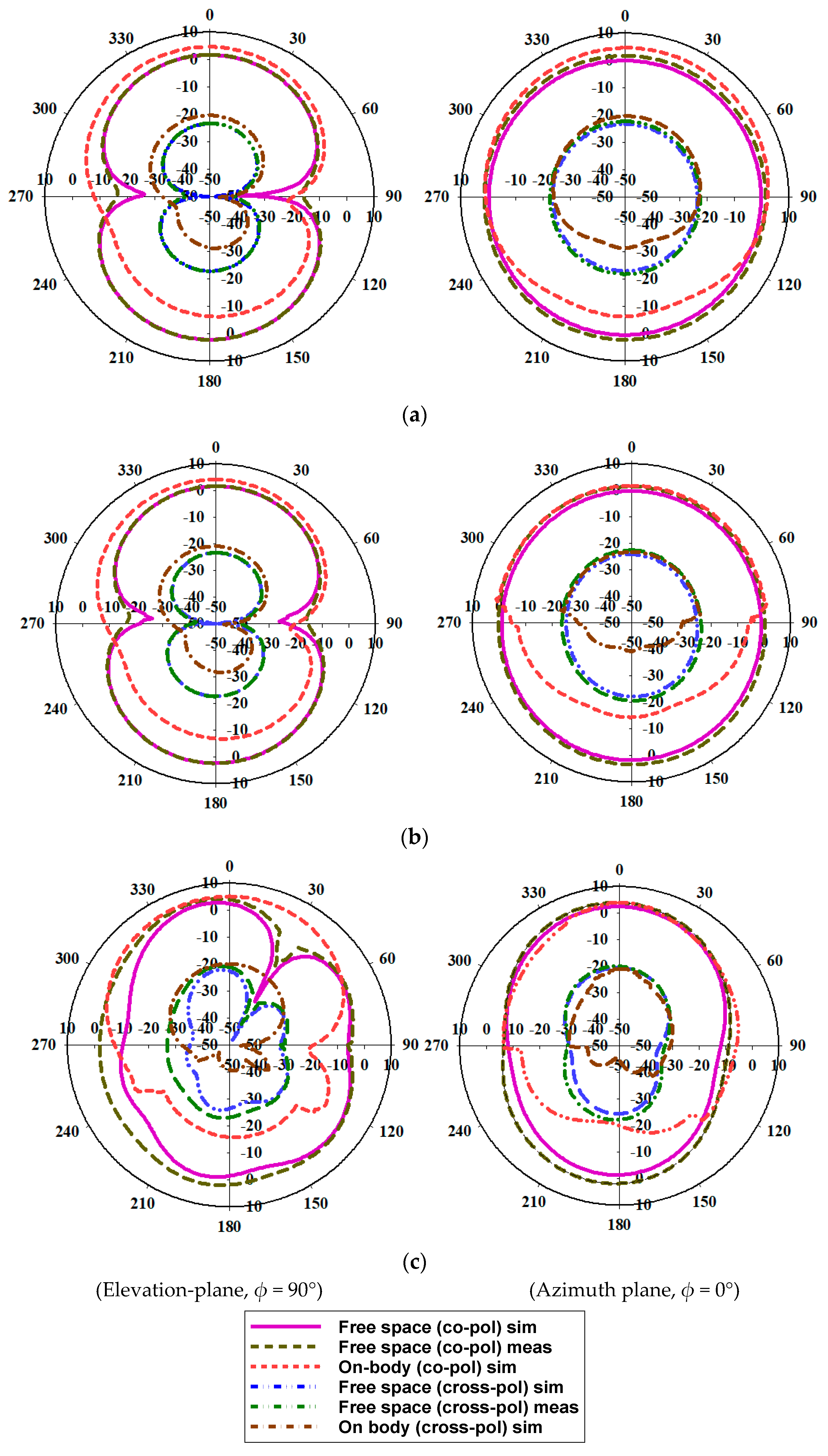
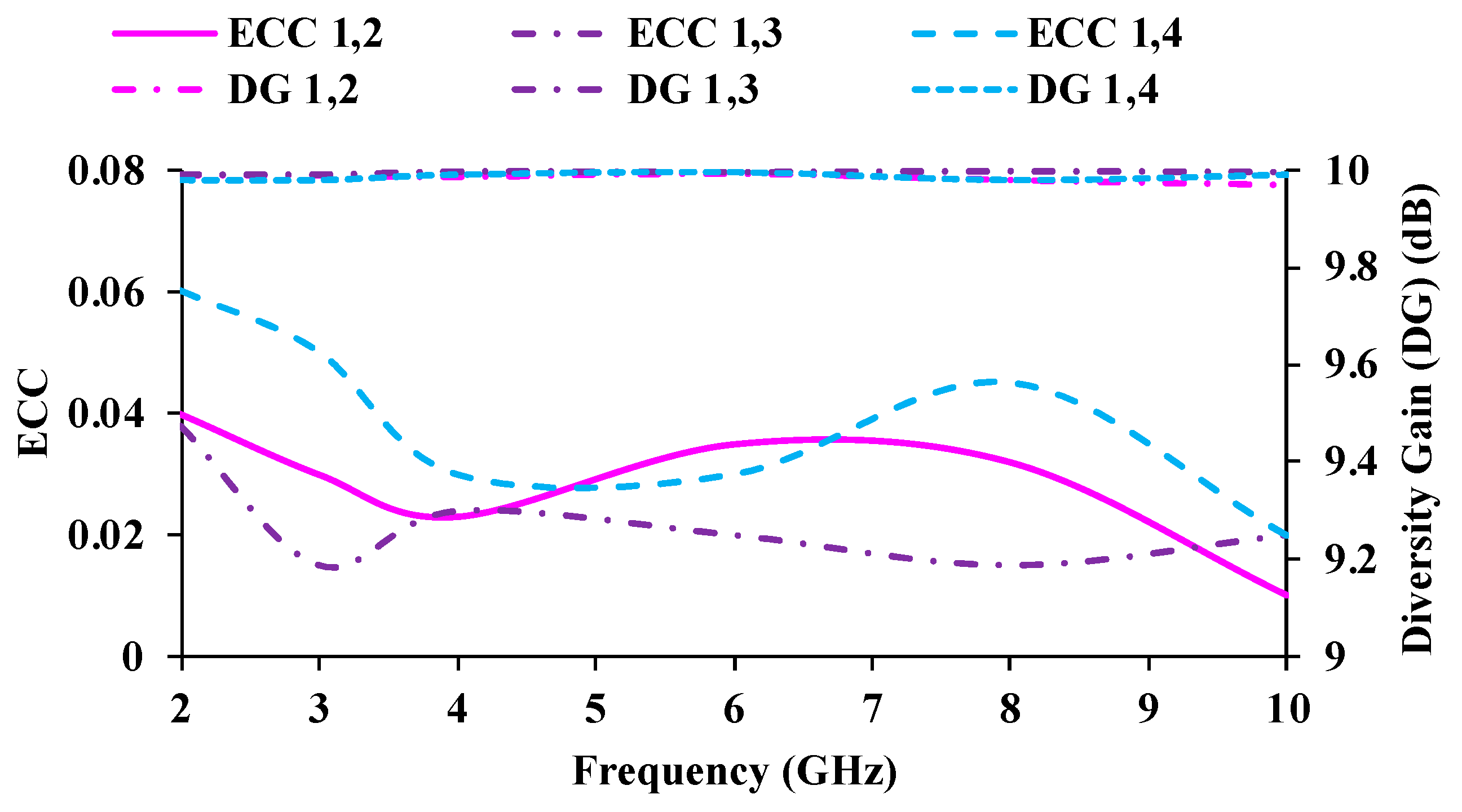
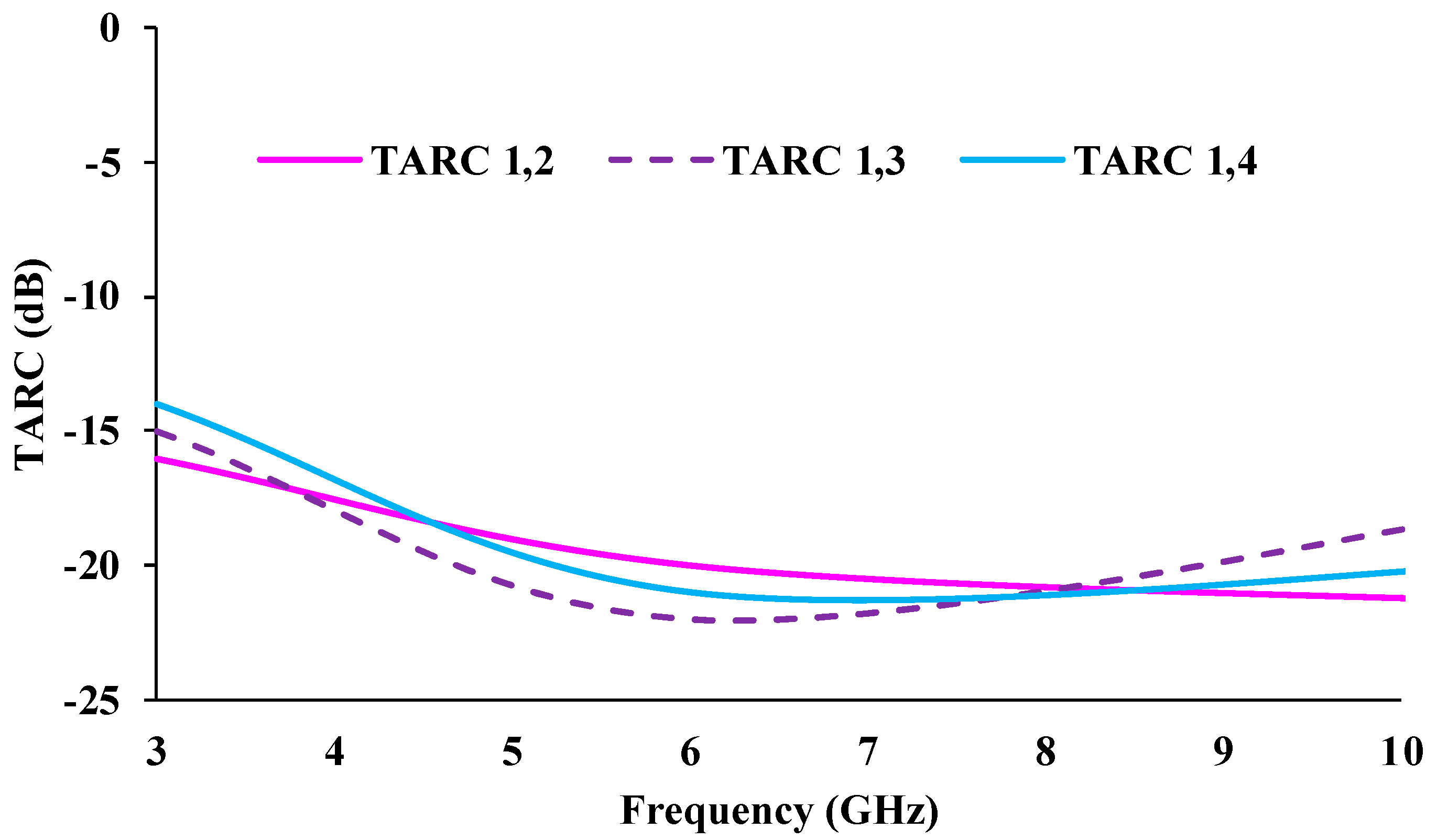

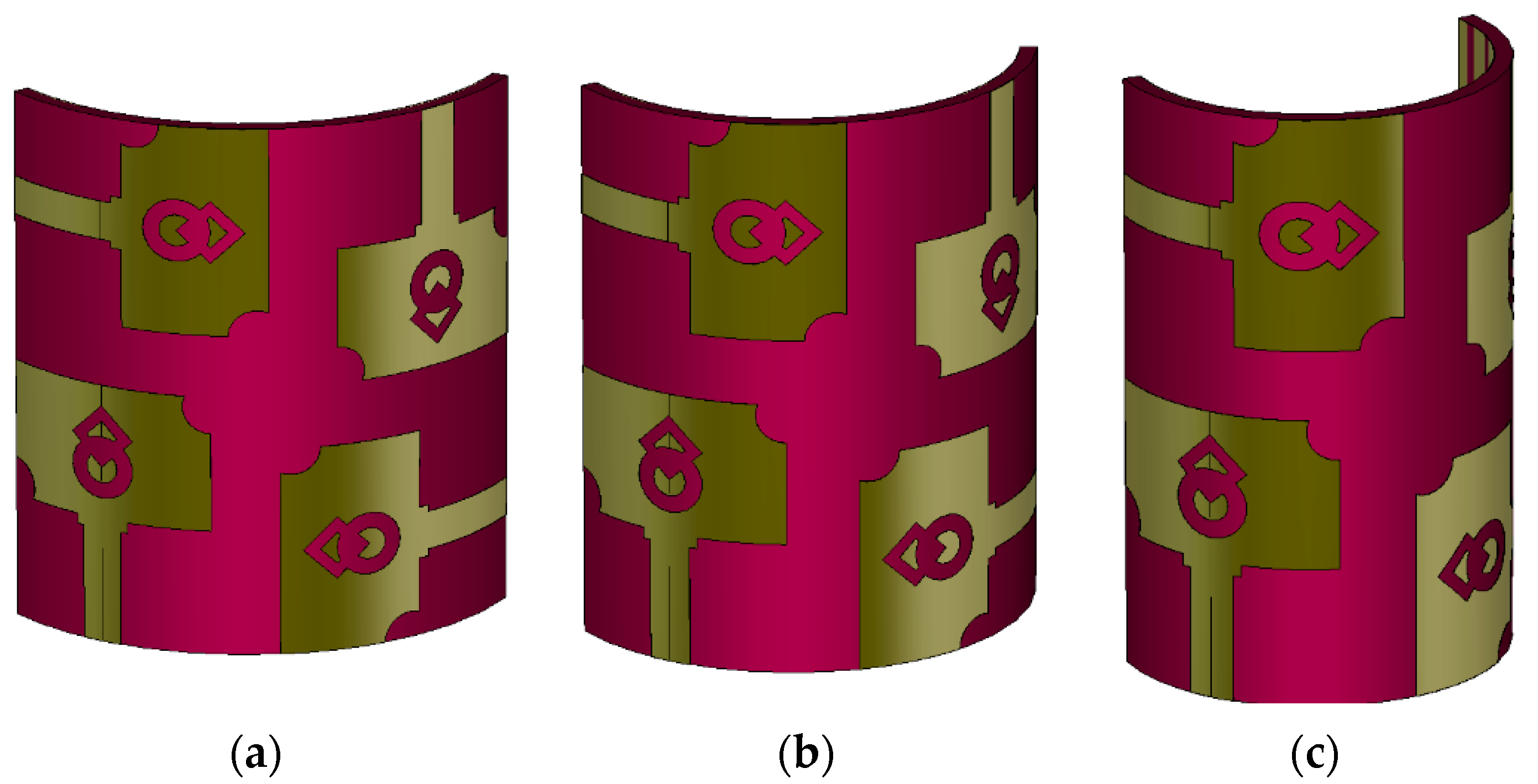

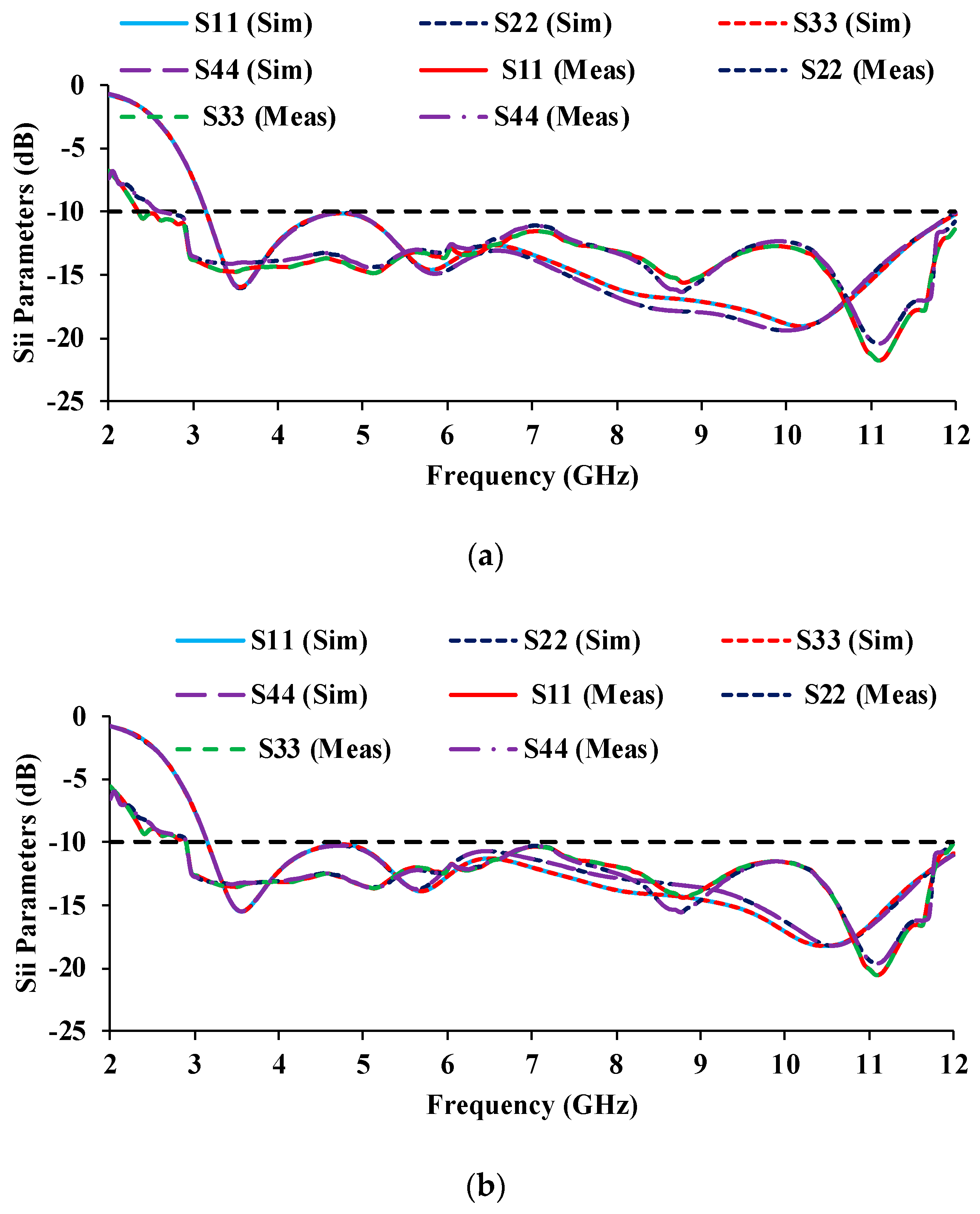
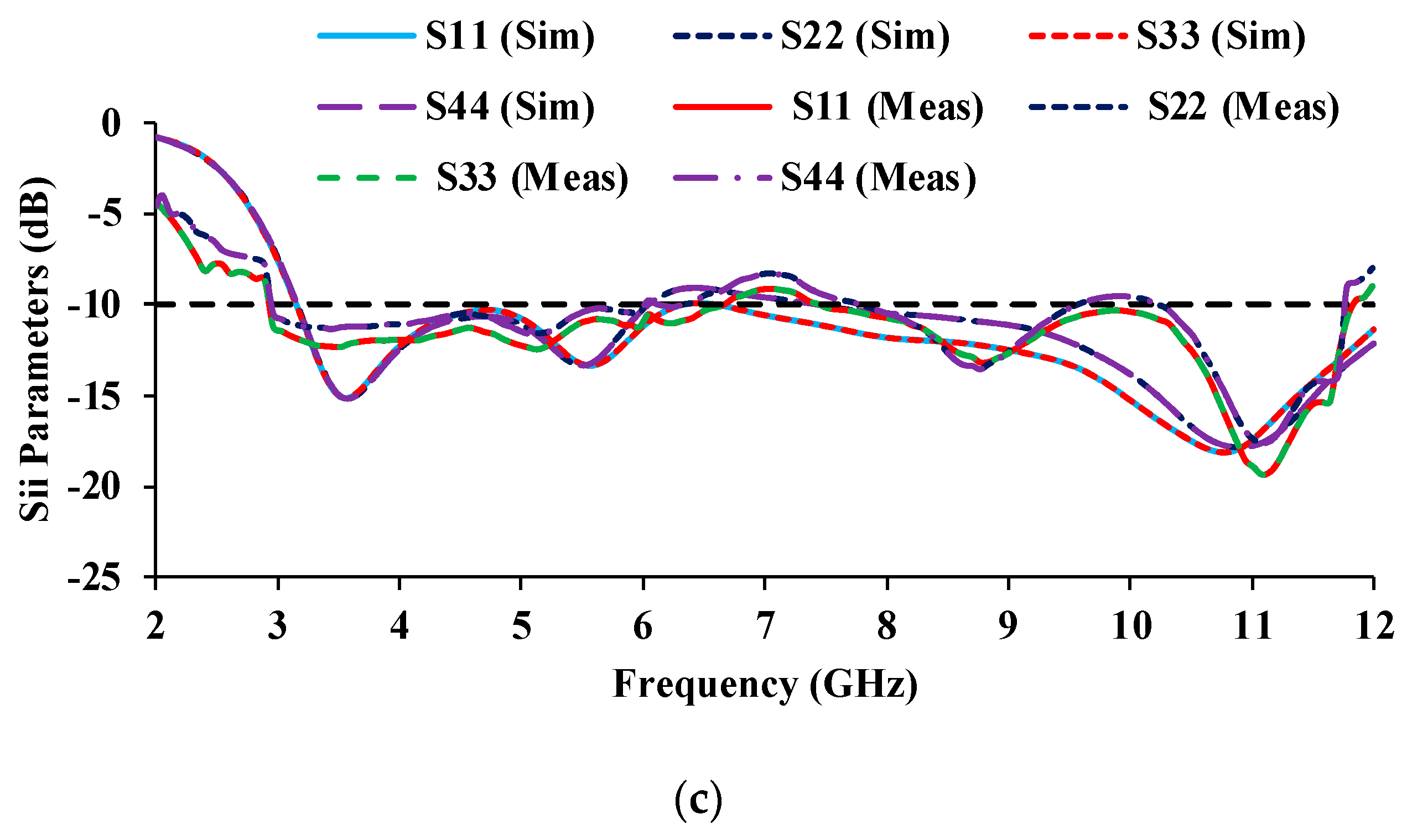
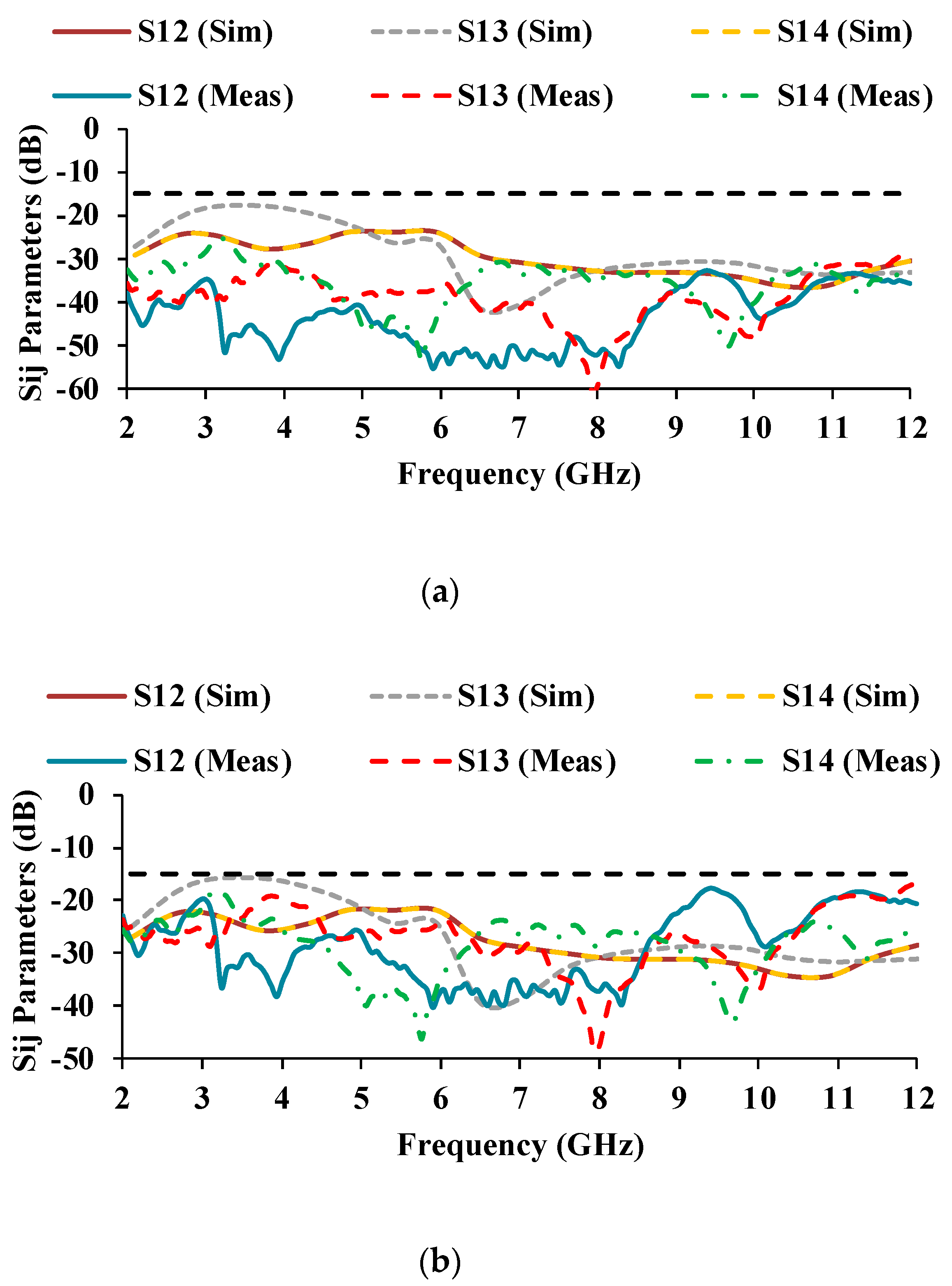
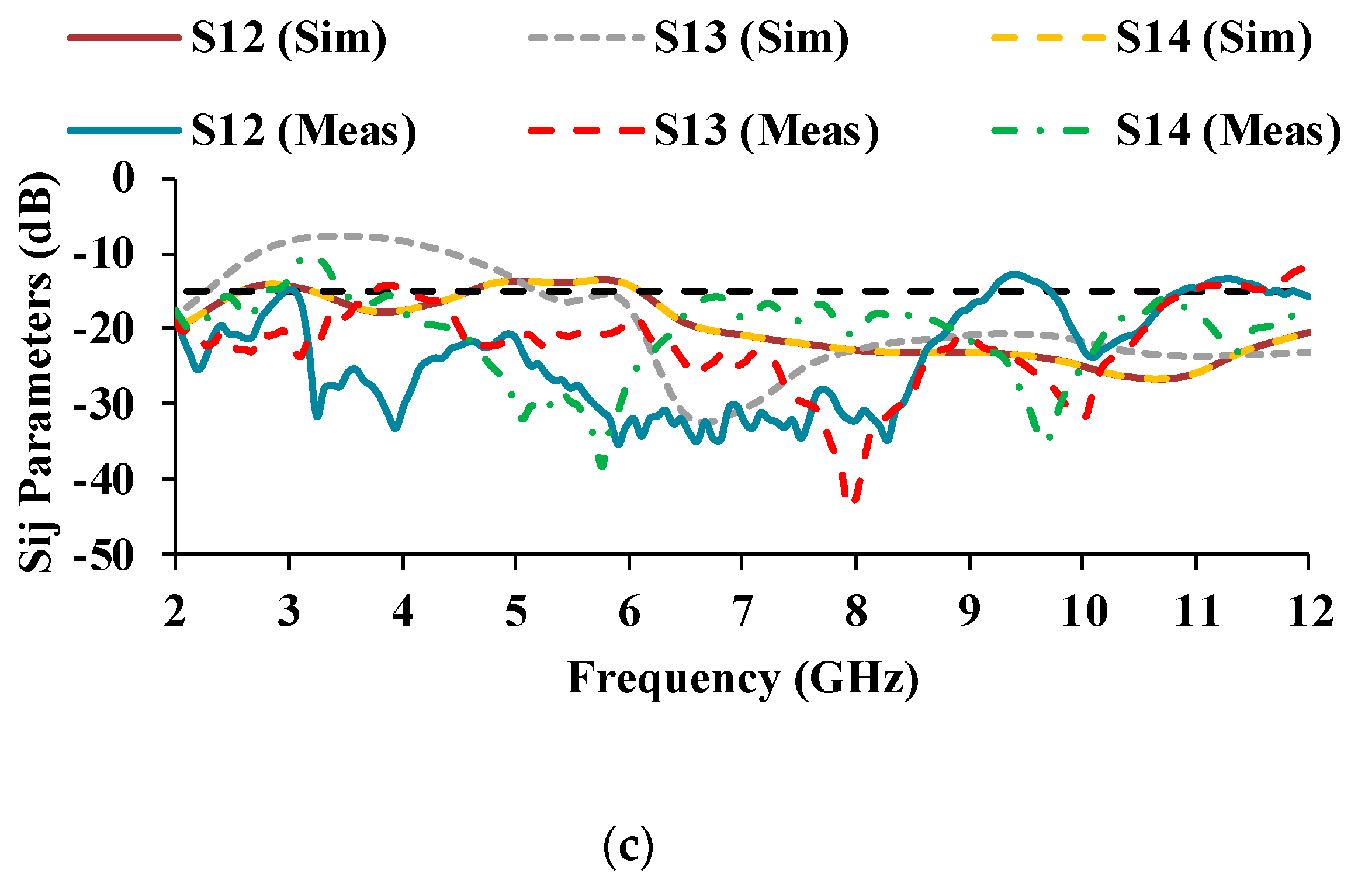

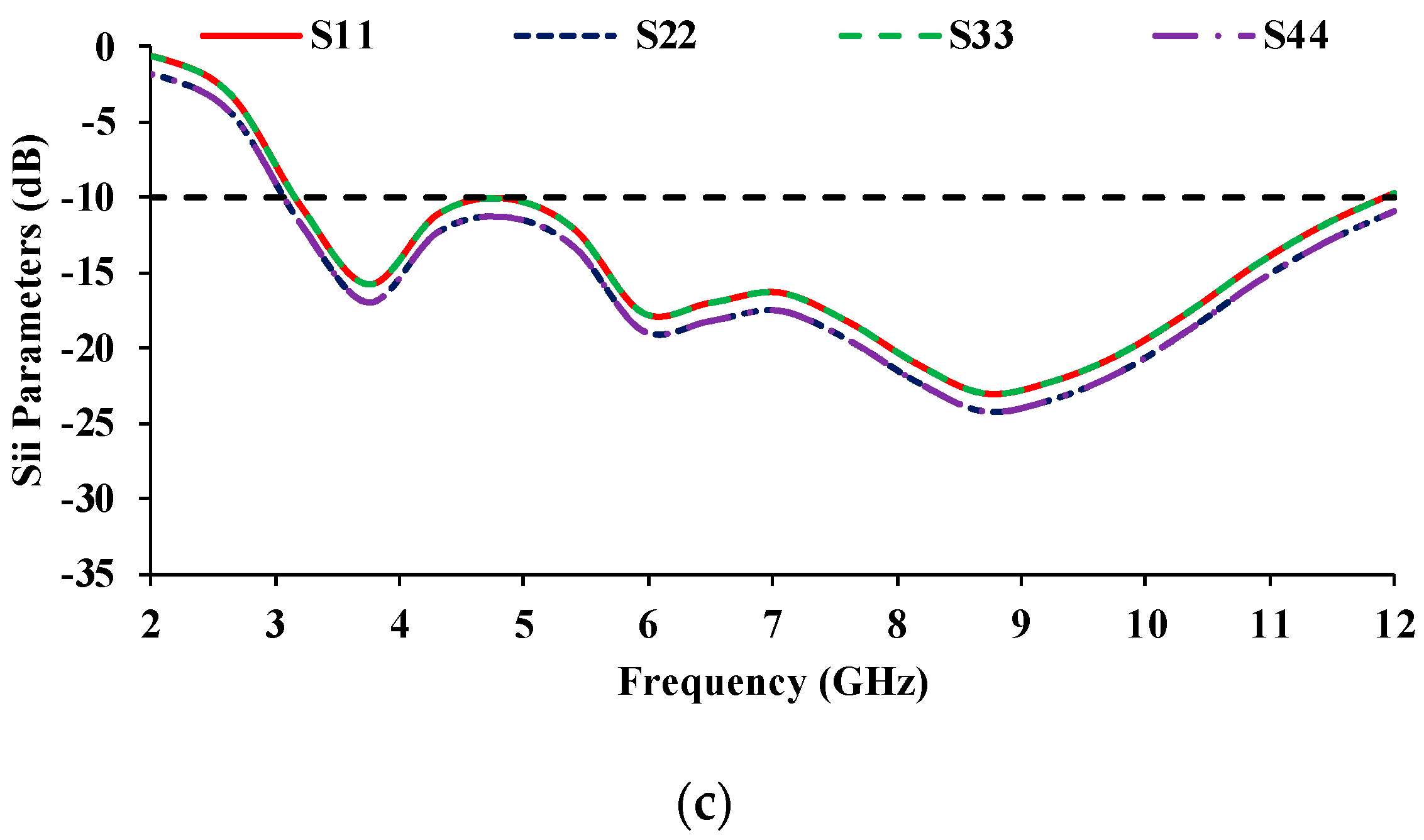
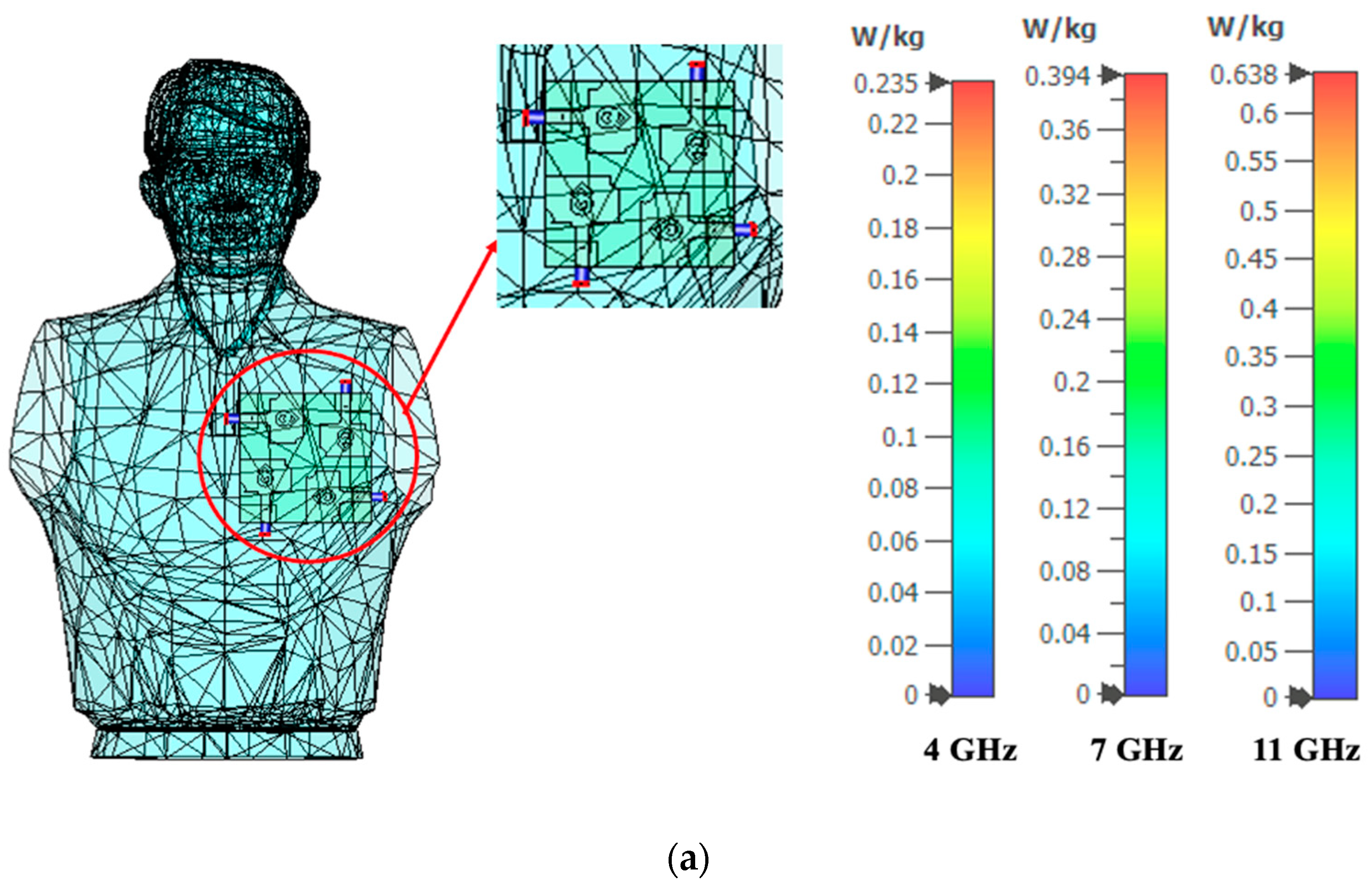
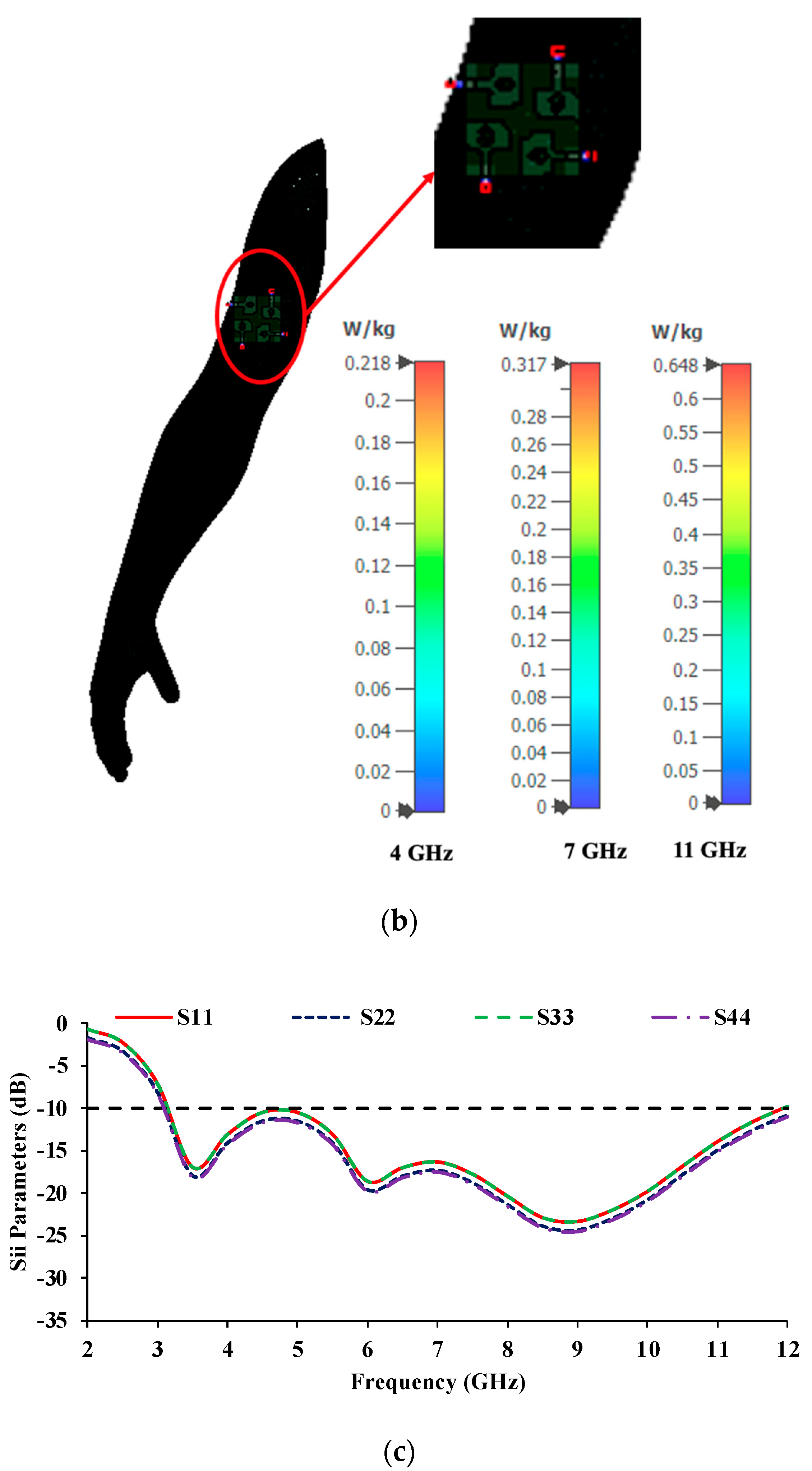


| Bending Radius (BR) | Bending Angle (°) |
|---|---|
| 25 mm | 116.94 |
| 20 mm | 146.2 |
| 15 mm | 194.9 |
| Human Body Tissue Layers | Frequency (GHz) | Relative Permittivity (εr) | tan δ | Thickness of Tissue Layers (mm) |
|---|---|---|---|---|
| Skin | 4 | 36.6 | 0.281 | 2 |
| 7 | 34.1 | 0.36 | ||
| 10 | 31.3 | 0.47 | ||
| Fat | 4 | 5.12 | 0.14 | 5 |
| 7 | 4.85 | 0.19 | ||
| 10 | 4.6 | 0.24 | ||
| Muscle | 4 | 50.8 | 0.23 | 10 |
| 7 | 46.9 | 0.33 | ||
| 10 | 42.8 | 0.45 | ||
| Bone | 4 | 10.5 | 0.16 | 7 |
| 7 | 9.17 | 0.183 | ||
| 10 | 8.12 | 0.21 |
| Ref. | Substrate | Unit Cell Area | MIMO Area | No. of Ports | Bandwidth (GHz) | Peak Gain (dBi) | DG (dB) |
|---|---|---|---|---|---|---|---|
| [36] | Denim | 36 × 29 | --- | 1 | 3–11 | 7.2 | --- |
| [37] | Jeans cotton | 65 × 60 | --- | 1 | 2.19–3 | --- | --- |
| [38] | Jeans | 16 × 28 | 40 × 86 | 2 | 2.42–2.47 | 3 | >9.5 |
| [39] | Felt | 37 × 34 | 37 × 76 | 2 | 2–6.23 | 2.88 | 9.95 |
| [40] | Felt | 36 × 27 | 36 × 54 | 2 | 1.1–8.6 | 7.5 | --- |
| [41] | Felt | 30.5 × 20 | 32.5 × 42 | 2 | 3.6–13 | 5.7 | >9.96 |
| [42] | Felt | 47.2 × 31 | 132.8 × 70 | 2 | 3.53–7.1 | 1.878, 4.027 | >9.975 |
| [43] | Jeans | 20 × 16 | 20 × 32 | 2 | 3.38–12.78 | --- | 9.99 |
| [44] | Jeans | 26 × 12 | 26 × 24 | 2 | 4.9–6 | 5.1 | 10 |
| [45] | Kapton | 22 × 15 | 22 × 31 | 2 | 3.43–10.1 | 3.5 | --- |
| [46] | FR-4 | 31 × 22 | 31 × 44 | 2 | 2.28–2.47 3.4–3.62 4.57–6.75 | 1.3 2.9 4.3 | 9.998 9.999 9.998 |
| Prop. | Polyester | 25 × 20 | 51 × 51 | 4 | 3.1–12 | 4.62 | >9.99 |
Publisher’s Note: MDPI stays neutral with regard to jurisdictional claims in published maps and institutional affiliations. |
© 2022 by the authors. Licensee MDPI, Basel, Switzerland. This article is an open access article distributed under the terms and conditions of the Creative Commons Attribution (CC BY) license (https://creativecommons.org/licenses/by/4.0/).
Share and Cite
Govindan, T.; Palaniswamy, S.K.; Kanagasabai, M.; Kumar, S.; Marey, M.; Mostafa, H. Design and Analysis of a Flexible Smart Apparel MIMO Antenna for Bio-Healthcare Applications. Micromachines 2022, 13, 1919. https://doi.org/10.3390/mi13111919
Govindan T, Palaniswamy SK, Kanagasabai M, Kumar S, Marey M, Mostafa H. Design and Analysis of a Flexible Smart Apparel MIMO Antenna for Bio-Healthcare Applications. Micromachines. 2022; 13(11):1919. https://doi.org/10.3390/mi13111919
Chicago/Turabian StyleGovindan, Thennarasi, Sandeep Kumar Palaniswamy, Malathi Kanagasabai, Sachin Kumar, Mohamed Marey, and Hala Mostafa. 2022. "Design and Analysis of a Flexible Smart Apparel MIMO Antenna for Bio-Healthcare Applications" Micromachines 13, no. 11: 1919. https://doi.org/10.3390/mi13111919
APA StyleGovindan, T., Palaniswamy, S. K., Kanagasabai, M., Kumar, S., Marey, M., & Mostafa, H. (2022). Design and Analysis of a Flexible Smart Apparel MIMO Antenna for Bio-Healthcare Applications. Micromachines, 13(11), 1919. https://doi.org/10.3390/mi13111919






